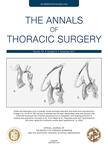版权所有:内蒙古大学图书馆 技术提供:维普资讯• 智图
内蒙古自治区呼和浩特市赛罕区大学西街235号 邮编: 010021

作者机构:Tech Univ Munich Klinikum Rechts Isar Med Klin D-81675 Munich Germany
出 版 物:《ANNALS OF THORACIC SURGERY》 (胸外科学纪事)
年 卷 期:1999年第68卷第6期
页 面:2123-2128页
核心收录:
学科分类:1002[医学-临床医学] 100210[医学-外科学(含:普外、骨外、泌尿外、胸心外、神外、整形、烧伤、野战外)] 10[医学]
主 题:抗感染药 局部/药理学 细菌/药物作用 细菌/生长和发育 生物相容性材料 除颤器 植入型 设备污染 大肠杆菌/药物作用 大肠杆菌/生长和发育 过氧化氢/药理学 心脏起搏器 人工 聚氨基甲酸酯类 聚硅酮类 葡萄球菌 表皮/药物作用 葡萄球菌 表皮/生长和发育 人类
摘 要:Background. Despite widespread use of potent antibiotics, infections of artificial implants and catheters are of increasing concern. We tested whether local treatment with 3% hydrogen peroxide (H2O2), long known as an inexpensive wound disinfectant, could prevent or reduce bacterial growth on polymer biomaterials. Methods. Two-centimeter-long pieces of polyurethane and silicone tubing were contaminated with a standardized solution of Staphylococcus epidermidis (10(5)/mL) and then rinsed and wiped with saline (0.9%) solution. Bacterial growth was assessed after incubation at 37 degrees C for 24 hours. Bacterial colonies were compared for the following treatments: wiping only with saline;wiping with 1.5%, 2%, or 3% H2O2;pretreating biomaterials with 3% H2O2 and subsequent contamination for 2 and 4 hours without treatment after contamination;and contamination of tubings I month after pretreatment with 30% H2O2. The effect of 3% H2O2 was also assessed on contamination with Escherichia coli. Results. Bacterial growth was reduced by more than 99% when the contaminated tubes were treated with 3% H2O2 compared with saline control (p 0.001). Lower concentrations of H2O2 were less effective. The length of the contamination period had no influence on the effectiveness of H2O2 when used on polyurethane but did with silicone tubings. Pretreatment with H2O2 1 month before contamination still reduced bacterial growth rate by 90% on polyurethane and by 75% on silicone tubings. Comparable effects on bacterial growth rate were observed for staphylococci (-90%, p 0.001) and escherichiae (-90%, p 0.001). Conclusions. Local treatment with 3% H2O2 significantly reduced bacterial growth on polymer biomaterials even for I month after treatment. This finding might influence clinical strategies of prevention of foreign body infection. (C) 1999 by The Society of Thoracic Surgeons.